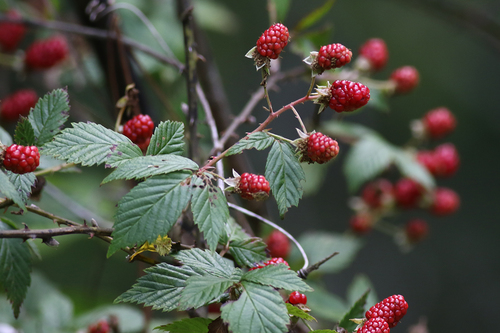Pennsylvania Blackberry
Search
Wikipedia
| Rubus pensilvanicus | |
|---|---|

| |
|
Scientific classification | |
| Kingdom: | Plantae |
| Clade: | Tracheophytes |
| Clade: | Angiosperms |
| Clade: | Eudicots |
| Clade: | Rosids |
| Order: | Rosales |
| Family: | Rosaceae |
| Genus: | Rubus |
| Species: |
R. pensilvanicus
|
| Binomial name | |
|
Rubus pensilvanicus
Poir. 1804
| |
| Synonyms[1] | |
| |
Rubus pensilvanicus, known commonly as Pennsylvania blackberry, is a prickly bramble native to eastern and central North America from Newfoundland south to Georgia, west as far as Ontario, Minnesota, Nebraska, and Arkansas. The species is also established as a naturalized plant in California.[2][3]
Rubus pensilvanicus is a prickly shrub up to 3 meters (10 feet) tall. The canes are green at first but then turn dark red, usually ridged, with copious straight prickles. The leaves are palmately compound, usually bearing 5 or 7 leaflets. The flowers are white with large petals, borne in mid-spring. The fruits are large aggregates of 10-100 black drupelets, somewhat sweet and often used for jams and jellies.[4]
The genetics of Rubus is extremely complex, making it difficult to separate the group into species. What some authors lump together as R. pensilvanicus, other authors split into as many as 50 or 60 species.[4]
References
- ^ "Rubus pensilvanicus". Richard Pankhurst et al. Royal Botanic Gardens Edinburgh – via The Plant List.CS1 maint: others (link)
- ^ "Rubus pensilvanicus". County-level distribution map from the North American Plant Atlas (NAPA). Biota of North America Program (BONAP). 2014.
- ^ Calflora taxon report, University of California, Rubus pensilvanicus Poiret, Pennsylvania blackberry
- ^ a b Alice, Lawrence A.; Goldman, Douglas H.; Macklin, James A.; Moore, Gerry (2014). "Rubus pensilvanicus". In Flora of North America Editorial Committee (ed.). Flora of North America North of Mexico (FNA). 9. New York and Oxford – via eFloras.org, Missouri Botanical Garden, St. Louis, MO & Harvard University Herbaria, Cambridge, MA.
External links
- Jepson Manual Treatment
- Illinois Wildflowers
- Go Botany, New England Wildflower Society
-
 Media related to Rubus pensilvanicus at Wikimedia Commons
Media related to Rubus pensilvanicus at Wikimedia Commons
